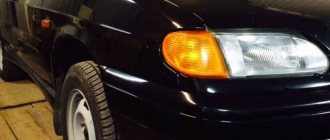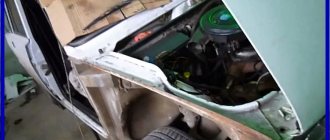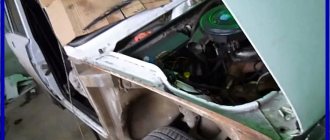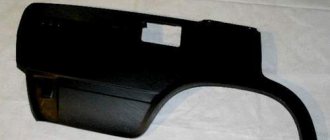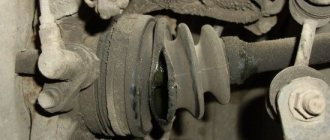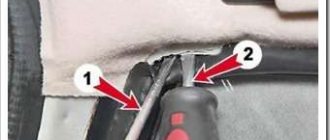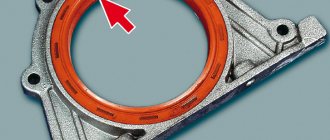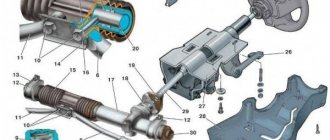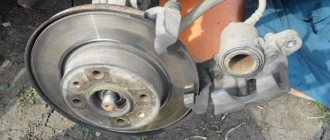How to remove the wing on a VAZ 2114
You will need the following:
- Remove the travel direction repeater. First, the socket is removed along with the lamp. Then, having found two special petals, you should simultaneously press them and completely remove the cartridge.
- Unscrew the nuts; they secure the part to the side of the bumper.
- Move the bumper down so that it does not interfere with the removal of the fender.
- Remove the screw; it secures the headlight cover.
- Open the hood, find the wiring harness and disconnect it.
- Remove the spring that secures the turn signal.
- From the outside, remove it from its niche. Remove all remaining bolts that secure the fender to the car body.
How to remove the wing on a VAZ 2114: consider the subtleties of the process
The cars coming off the VAZ assembly line were distinguished by fairly durable body elements.
This was explained by the fact that domestic designers, taking into account the operating features of such machines, made every effort to give all components characteristics that ensure uninterrupted operation for a long time. Over time, the development of technology has made it possible to use new materials that significantly reduce the overall weight of the car. However, this point had some negative impact on the strength of body elements.
So, for example, on a VAZ 2114, the front wings are the parts that are most often damaged during operation.
The causes of such damage may be:
- car accidents;
- consequences of unsuccessful parking maneuvers;
- natural wear and tear, etc.
That is why it will not be superfluous for car owners of such models to learn how to change the front fender on a VAZ 2114. This information will allow you to easily repair the car with your own hands, as well as competently carry out its maintenance.
Regardless of what was the reason for removing the wing (its straightening or replacement), it is important to properly prepare for the procedure.
When the VAZ 2114 wing requires replacement
- As already noted, the impact on the wing of the environment and moisture, especially in winter, when the roads are sprinkled with salt and all kinds of reagents, becomes extremely destructive.
In order to prevent the wings and body of the car from reaching a critical state, it is necessary to carry out anti-corrosion treatment on the VAZ 2114 in a timely manner.
If the wing is deformed as a result of an accident, it is better to buy a new part. Small dents, abrasions and chips on the wing, at first do not cause serious concern. Over time, they become covered with rust, the “attractiveness” of the wing is lost, and as a result, the need to replace the wing.
In order not to spend money on repairs in a car repair shop, an experienced car owner, if he has the tools, can change the wings of a VAZ 2114 with his own hands. It is better to replace the front wing of a VAZ 2114 in a garage, following the instructions.
To perform this procedure you will need a tool such as:
- wrench with 8 and 10 mm head;
- extension cord and ratchet;
- flat and Phillips screwdriver;
- new left wing of VAZ 2114.
By the way, the price for an original VAZ front left fender with article number 21140840301100 or a front right fender with article number 21140840301000 will be about 1,800 rubles. The cost of the rear right wing with article number 21090840401400 or the rear left wing with article number 21090840401100 will be about 2100 rubles.
Prices are indicated for spring 2021 in Moscow and the region.
Replacing the front wing on a VAZ 2113, VAZ 2114, VAZ 2115
Welcome! Front fender - sometimes this part is very often subject to impact, just like the front bumper, so people mostly replace a dented fender immediately with a new one, but not everyone knows how to change the front fender on cars of the Samara 2 family, which is why we wrote this instruction in which they explained in detail the process of replacing a wing on a car.
Note! In order to replace the wing, you will need to stock up on: Firstly, a screwdriver, secondly, a set of wrenches, and you should also stock up on a set of ring wrenches, and also take with you small pliers in order to remove the sill mounting piston and Just in case, stock up on anti-corrosion agent because over time, the standard anti-corrosion compound that is used to coat the car from the factory becomes worse or disappears altogether!
Preparation for wing replacement and necessary tools
First you need to prepare the car itself. To do this, he should drive the VAZ 2114 into a technical pit or overpass. If this is not possible, then it will be enough to simply lift it with a jack on the side from which the wing will be replaced and securely fix it in this position. Next, you need to remove the wheel and remove all interfering parts. These include:
- front bumper;
- facing linings;
- thresholds;
- wheel arch liners
This is interesting: Diagnostics of injectors - how to check it yourself: step-by-step instructions Before removing the bumper, you need to disconnect the contacts of the fog lights. To do this, simply remove the terminal with “minus” polarity from the battery. Such a simple procedure will significantly reduce the risk of damage to all vehicle electronics, saving the owner from unnecessary financial costs.
Front bumper
For independent work you will need the following materials and tools:
- socket wrench with 8, 10 head;
- flat-head screwdriver;
- ratchet, extension;
- rags;
- pliers or pliers;
- knife;
- anti-corrosion lubricant WD-40;
- new part.
It should be noted that in the process of replacing a wing, not all of the above tools may be needed. It will be enough for an experienced master to have only a few of them on hand. However, if this is your first time deciding to remove the wing yourself, then it is better to prepare the entire kit so that during the work you will not be distracted by searching for the missing tools.
After completing all the preparatory work, you can begin replacing the old VAZ 2114 wing and installing a new one.
Replacing the wing of a VAZ 2114: how to prepare the car and what tools are needed
Before removing the wing of the VAZ 2114, you should prepare the car and collect the necessary tools.
The car needs to be driven into a technical pit/overpass, and if this is not possible, jacked up on the side from which you are going to change the wing.
Wing VAZ 2114
The car should be securely fixed in this position.
After this, you can remove the wheel and all parts that may interfere with the process, namely:
- front bumper;
- facing linings;
- wheel arch liners;
- thresholds.
Bumper VAZ 2114
Before removing the bumper, be sure to disconnect the contacts of the fog lights. To avoid damaging the car’s electronics, remove the “-” terminal on the battery.
Of the tools that you will need to quickly replace the front fender, you will need the following:
- Set of wrenches.
- Set of spanners.
- Extension.
- Phillips screwdriver.
- Pliers.
- Knife.
It should be noted that in the process of replacing a wing, not all of the above tools may be needed. It will be enough for an experienced master to have only a few of them on hand. However, if this is your first time deciding to remove the wing yourself, then it is better to prepare the entire kit so that during the work you will not be distracted by searching for the missing tools.
Maintenance
In accordance with the manufacturer's regulations, engine 11186 must be serviced in the following order:
| Oil consumption | maximum 1 l/1000 km |
| Engine oil for 11186 | 5W-30 and 10W-30 |
| Engine oil volume | 3.5 l |
| Operating temperature | 95° |
| Motor life | stated 150,000 km |
| Adjustment of valves | washers between camshaft cams and tappets |
| Cooling system | forced, antifreeze/antifreeze |
| Coolant quantity | 7.8 l |
| water pump | polymer impeller |
| Candles for 11186 | BPR6ES, A17DVRM |
| Gap between spark plug electrodes | 1.1 mm |
| Timing belt | 163 teeth, pitch 8 mm, belt width 26.7 mm |
| Cylinder operating order | 1-3-4-2 |
| Air filter | Nitto, Knecht, Fram, WIX, Hengst |
| Oil filter | catalog number 90915-10001 |
| Flywheel | from 2110, steel crown placed on a cast iron body |
| Flywheel mounting bolts | MT box – M10x1.25 mm, length 26 mm, groove 11 mm |
| Valve stem seals | code 90913-02090 light inlet |
| Compression | 13 bar |
| XX speed | 650 – 750 min -1 |
| Tightening force of threaded connections | spark plug – 18 Nm |
| Maintenance object | Time (year) or mileage (1000 km), |
which comes first
This is exactly the frequency of maintenance that the ICE 11186 device is designed for.
Features of replacing the rear wing of a VAZ 2114
It should be taken into account that the process of replacing the rear wing of a VAZ 2114 is much more difficult and complex, and requires the necessary specialized tools (for example, a welding machine) and highly qualified plumbing work.
Below is a DIY guide for replacing your rear fender.
- We remove unnecessary and flammable items from the trunk.
- Unscrew the bumper.
- Disconnect the headlights.
- Remove the seal.
- We remove the fuel tank if the right wing is to be replaced.
- We dismantle the glass of the rear wing, it is removed like a windshield.
- Using precise movements, using a thin chisel or a grinder, cut along the wing, adhering to the joint indentations:
Replacing the wing of a VAZ 2114. Photos, instructions on how to change the wing of a VAZ 2114
The VAZ 2114 car of the Samara 2 family is a restyled version of the VAZ 2109. The model differs from its predecessor in the original design of the front part of the body, headlights, hood, design of bumpers and moldings.
During the operation of the car, damage to the body occurs, this is facilitated by corrosion, minor accidents, and the external environment. Wings are also susceptible to these negative influences, which is why they sometimes require replacement.
This photo report shows how the front wing of a VAZ 2114 is replaced.
Features of replacing the rear wing of a VAZ 2114
It should be taken into account that the process of replacing the rear wing of a VAZ 2114 is much more difficult and complex, and requires the necessary specialized tools (for example, a welding machine) and highly qualified plumbing work. https://www.youtube.com/watch?v=hwG_-_erfbY
https://www.youtube.com/watch?v=hwG_-_erfbY
You can do your own VAZ repairs only if you understand body work and know how to work with a welding machine. When you encounter it for the first time, you are unlikely to be able to perform high-quality repairs.
Below is a DIY guide for replacing your rear fender.
- We remove unnecessary and flammable items from the trunk.
- Unscrew the bumper.
- Disconnect the headlights.
- Remove the seal.
- We remove the fuel tank if the right wing is to be replaced.
- We dismantle the glass of the rear wing, it is removed like a windshield.
- Using precise movements, using a thin chisel or a grinder, cut along the fender, adhering to the joint indentations:
From the rear wheel arch along the bend, 12–15 mm away from the edge of the fender; from the floor of the spare wheel (or fuel tank) along the bend, 12–15 mm away from the edge of the wing; from the rear panel, 2 mm away from the connection line; from the cross member panel of the rear window, 2–3 mm away from the edge of the bend; from the rear of the sidewall along the bend, 15–20 mm away from the edge of the wing. - Using a drill with a diameter of 6–7 mm, we drill out the rivets at the junction of the wing with the transverse frame.
- Disconnect the rear fender.
- Using a tool, we remove excess metal that remains on the body.
- We straighten and polish the edges of the wing.
- We attach the new wing using resistance welding in increments of 40–50 mm.
- We paint the new wing in the body color.
When the VAZ 2114 wing requires replacement
- As already noted, the impact on the wing of the environment and moisture, especially in winter, when the roads are sprinkled with salt and all kinds of reagents, becomes extremely destructive.
In order to prevent the wings and body of the car from reaching a critical state, it is necessary to carry out anti-corrosion treatment on the VAZ 2114 in a timely manner. - If the wing is deformed as a result of an accident, it is better to buy a new part.
- Small dents, abrasions and chips on the wing, at first do not cause serious concern. Over time, they become covered with rust, the “attractiveness” of the wing is lost, and as a result, the need to replace the wing.
In order not to spend money on repairs in a car repair shop, an experienced car owner, if he has the tools, can change the wings of a VAZ 2114 with his own hands. It is better to replace the front wing of a VAZ 2114 in a garage, following the instructions.
To perform this procedure you will need a tool such as:
- wrench with 8 and 10 mm head;
- extension cord and ratchet;
- flat and Phillips screwdriver;
- new left wing of VAZ 2114.
By the way, the price for an original VAZ front left fender with article number 21140840301100 or a front right fender with article number 21140840301000 will be about 1,800 rubles. The cost of the rear right wing with article number 21090840401400 or the rear left wing with article number 21090840401100 will be about 2100 rubles.
Prices are indicated for spring 2021 in Moscow and the region.
1
Unscrew the two screws securing the front fender liner to the bottom of the mudguard.
2
Unscrew the nuts securing the fender liner to the upper part of the body.
3
Remove the three screws securing the fender liner to the bottom of the front bumper and remove the fender liner.
4
Remove the door sill trim.
5
Remove the molding (if any) of the front fender.
6
After unscrewing the screw securing the headlight trim, remove the front turn signal.
7
Next, using a 10mm head, unscrew the two self-tapping screws fastening to the front pillar (under the wing).
8
Using a 10mm wrench, unscrew the front (lower) wing screw to the bracket.
9
Using the same “10” wrench, we unscrew the rear (lower) screw securing the wing to the body sill.
10
Move the side turn signal slightly forward and pull out its rear part.
11
Using a 10mm wrench, unscrew the four upper bolts securing the wing to the body.
12
Completely remove the side turn signal. Separating the left wing from the factory mastic, remove it.
13
We install the wing in the reverse order of removal.
Replacing the front wing on a VAZ 2113-VAZ 2115
Note! First you need to remove the screws and bolts that secure the excess parts to the car. Superfluous in today's context, this includes wheel arch liners, the front bumper (namely, the side bolts for attaching to the car fender and facing trims), and the sill.
Important! Before starting work, be sure to disconnect the negative terminal from the battery so that when working with electronics you do not damage anything and inadvertently get electrocuted.
Removal
1) At the beginning of the operation, carefully, without damaging the paint, use a screwdriver to pry up the front piston securing the molding and remove it. Next, move the molding slightly to the side and remove the rear fastening piston. Now remove the front molding completely from the car fender.
2) Then, using pliers (shown in the small picture below), completely remove the piston securing the upper part of the threshold (the place where the threshold is attached is indicated by a green arrow). Then take a screwdriver in your hands and use it to unscrew the five upper screws securing the threshold (these screws are indicated by red arrows). Remove the three bottom screws (indicated by blue arrows) securing the front of the car sill. After unscrewing all the screws securing the front part, remove it from the car.
3) Now you need to remove the fender liner. It is best to do this on a viewing hole or on a lift. If these conditions do not exist, lift the vehicle using a jack. Next, remove the wheel, because screws and nuts are not easily accessible. For instructions on how to remove wheels, see the article: “Correctly replacing a wheel on a VAZ.” If you are a thin person and know the location of the bolts well, you can probably do it without lifting the car, even on a jack, without removing the wheels.
4) Next, when the car is suspended or standing on the ground (depending on your choice), pick up a wrench or a socket wrench and use them to unscrew the two bolts (indicated by red arrows) securing the fender liner to the car mudguard. Then remove the single nut (indicated in blue) that secures the rear of the fender liner to the body of the car.
Note! There is a pressure plate under the nut and two washers under the bolts. Carefully remove the parts and do not lose them; without them, you will not be able to reattach the fender liner!
5) Now use a screwdriver to unscrew the three screws (in the photo the central screw has already been turned out) located below and securing the fender liner to the car bumper. Take a wrench in your hands and unscrew the bolt, indicated by the blue arrow, securing the fender liner to the bottom of the car mudguard.
6) And to finish removing the fender liner, use a wrench to unscrew the 2 bolts securing the fender liner at the very top. Now remove it from the car.
Note! To prevent the threads on bolts and screws from rotting, we recommend that you lubricate them with some autoplasticine - apply to the cleaned open areas of the threaded surface.
7) Next, you need to remove the turn signal. Reach into the inside of the wing with your hand and find the socket that goes with the lamp. Remove this cartridge by simply pulling it (see small photo). Find the two petals indicated by the arrows in the large photo, and by clicking on them, completely remove the turn signal from the car's fender.
 Then crawl under the front of the car and look on the side for the nuts that secure the fender to the side of the front bumper. Move the bumper down (shown in the small picture below) so that it does not interfere with the removal of the fender.
Then crawl under the front of the car and look on the side for the nuts that secure the fender to the side of the front bumper. Move the bumper down (shown in the small picture below) so that it does not interfere with the removal of the fender.
9) Now, using a screwdriver, remove the screw that secures the headlight cover.
10) Then open the hood and, from the engine compartment, look for the wiring block that is connected to the turn signal of the headlight unit. Disconnect it from the pointer by pressing the fastening lock.
11) Next, disconnect the spring shown in the photo below. This spring secures the turn signal, so disconnect it from the pointer, grab it from the outside with your hand and completely remove it from the car.
12) And to complete the operation, you will need to unscrew the bolts securing the fender to the car. Their locations are shown in the image below:
Note! Unscrew the bolts depending on the numbering of a particular small picture. For example, start with the bolt numbered 1; this bolt is located on the side of the fender and can only be seen by moving the side of the car bumper down.
In the second photo, the bolt is located at the bottom, in the place where the wing ends and the threshold of the car begins.
In photo 3, you will need to unscrew 2 bolts located in the inner part of the wing and securing it to the body pillar. And you can see them by washing off the dirt from the fender liner.
In the image with the number 4, the arrows indicate four bolts that secure the wing to the body at the top of the car.
Installation
The new wing is installed on the car in the reverse order of removal. Treat the contact points between the wing and the body with anti-corrosion agent to avoid rot and damage to the elements.
Additional video
Not every wing unevenness requires immediate replacement. Sometimes restoration comes to the rescue. Below is a video about the repair of the wing, we recommend that you watch it:
In what cases will it be necessary to remove the wing?
The front fenders of any car, including 2114, are one of the most vulnerable elements of the body. It is they, along with the front bumper, that are primarily subject to mechanical damage as a result of the car being involved in various accidents. In addition, due to the extensive treatment of the road surface in winter with salt and chemicals, the parts begin to rust intensively.
Typically replacement occurs when:
- Severe mechanical damage as a result of an accident.
- Mechanical wear as a result of long-term use. This refers to numerous small mechanical irregularities that can no longer be completely eliminated by straightening.
- Numerous extensive areas of corrosion. In particularly advanced cases, it “eats” through the metal.
Compliance with the tightening torque of the cylinder head bolts
To control the process, it is necessary to follow a certain technique. In this way, the process can be controlled, preventing errors. To do this, you need to use a special key. A torque wrench will allow you to control the tightening torque.
First of all, using a torque wrench, set the holder to the zero position. This means the device readings are equal to the moment of the initial position of the holder
Now, you need to pay attention to the device indicator at the moment the fastener starts. We begin to twist the holder and look at the indicators. If the moment remains unchanged, then the fastener is tensile.
This is the norm. If the torque increases sharply, it is necessary to ensure that the bolt moves. This fact indicates insufficient stretching of the holder. In such a situation, adjustment is made after stabilization
If the moment remains unchanged, then the fastener is tensile. This is the norm. If the torque increases sharply, it is necessary to ensure that the bolt moves. This fact indicates insufficient stretching of the holder. In such a situation, adjustment is made after stabilization.
To control the process, you need to understand the following:
If, when tightening the bolts, the torque increases, the holder is durable and there is a need to replace it. If there is a decrease at the moment of tightening, the fastener is damaged and also needs to be replaced. During operation of a VAZ 2109 car, the cylinder head bolts are constantly exposed to destructive forces. During operation, the holders constantly heat up and cool down. This thermal effect gradually destroys the structure of the fasteners. Understanding the difficult operating conditions of bolts, you should take seriously the recommendations for their replacement.
Basic rules for adjusting cylinder head holders
Regardless of the characteristics of the engine of a particular car, there is a general number of rules that must be followed during work. It is necessary to strictly follow the parameters specified in the manufacturer's instructions. The work should be carried out using a torque wrench. Using an analogue may lead to undesirable results. Only bolts that are in good working order can be tightened. Before starting work, carefully check the condition of the holders. Tightening torque indicators must be strictly taken into account and not deviate from those specified by the manufacturer. When repairing the cylinder head of a VAZ 2109, you should follow the tightening instructions specified in the included instructions.
Most of the particularly important features of bolt adjustment are indicated in the instructions for a particular car. Therefore, it is necessary to carefully study the operating and maintenance manual of the machine. When operating a vehicle, comply with the manufacturer's requirements and regularly maintain the vehicle. Correct engine operation prevents the need to adjust the cylinder head holders.
Since the cylinder head has a complex structure, it is necessary to carry out repairs only with full confidence in your knowledge. If problems arise in the operation of the car engine, it is necessary to promptly carry out professional diagnostics. Thereby, you will prevent large-scale car repairs and high costs.
Repairing the cylinder head is a complex procedure that requires a sufficient amount of knowledge and certain experience. To carry out repairs, special equipment is used, which is usually available only in specialized service centers. Repairing the cylinder head involves changing the cylinder head gasket and adjusting the torque of the bolts. For correct adjustment, you must strictly follow the requirements specified in the instructions reviewed. Follow the manufacturer's specifications and use quality tools. With a careful approach, you can successfully make adjustments, obtaining the desired result. Happy renovation!
Replacing the wing of a VAZ 2114
The VAZ 2114 car of the Samara 2 family is a restyled version of the VAZ 2109. The model differs from its predecessor in the original design of the front part of the body, headlights, hood, design of bumpers and moldings. During the operation of the car, damage to the body occurs, this is facilitated by corrosion, minor accidents, and the external environment. Wings are also susceptible to these negative influences, which is why they sometimes require replacement. This photo report shows how the front wing of a VAZ 2114 is replaced.
Features of replacing the rear wing of a VAZ 2114
It should be taken into account that the process of replacing the rear wing of a VAZ 2114 is much more difficult and complex, and requires the necessary specialized tools (for example, a welding machine) and highly qualified plumbing work.
Below is a DIY guide for replacing your rear fender.
- We remove unnecessary and flammable items from the trunk.
- Unscrew the bumper.
- Disconnect the headlights.
- Remove the seal.
- We remove the fuel tank if the right wing is to be replaced.
- We dismantle the glass of the rear wing, it is removed like a windshield.
- Using precise movements, using a thin chisel or a grinder, cut along the wing, adhering to the joint indentations:
When the VAZ 2114 wing requires replacement
- As already noted, the impact on the wing of the environment and moisture, especially in winter, when the roads are sprinkled with salt and all kinds of reagents, becomes extremely destructive.
In order not to spend money on repairs in a car repair shop, an experienced car owner, if he has the tools, can change the wings of a VAZ 2114 with his own hands. It is better to replace the front wing of a VAZ 2114 in a garage, following the instructions.
To perform this procedure you will need a tool such as:
- wrench with 8 and 10 mm head;
- extension cord and ratchet;
- flat and Phillips screwdriver;
- new left wing of VAZ 2114.
By the way, the price for an original VAZ front left fender with article number 21140840301100 or a front right fender with article number 21140840301000 will be about 1,800 rubles. The cost of the rear right wing with article number 21090840401400 or the rear left wing with article number 21090840401100 will be about 2100 rubles.
Prices are indicated for spring 2021 in Moscow and the region.
Unscrew the two screws securing the front fender liner to the bottom of the mudguard.
Unscrew the nuts securing the fender liner to the upper part of the body.
Remove the three screws securing the fender liner to the bottom of the front bumper and remove the fender liner.
Remove the door sill trim.
Remove the molding (if any) of the front fender.
After unscrewing the screw securing the headlight trim, remove the front turn signal.
Next, using a 10mm head, unscrew the two self-tapping screws fastening to the front pillar (under the wing).
Using a 10mm wrench, unscrew the front (lower) wing screw to the bracket.
Using the same “10” wrench, we unscrew the rear (lower) screw securing the wing to the body sill.
Move the side turn signal slightly forward and pull out its rear part.
Using a 10mm wrench, unscrew the four upper bolts securing the wing to the body.
Completely remove the side turn signal. Separating the left wing from the factory mastic, remove it.
Screw. How to determine size?
A nut is a fastener for a screw drive or threaded connection. They differ from other parts by having a threaded hole. Together with the bolt (screw), it forms a screw pair. The nuts that thread onto a stud or bolt make up a bolted joint. Most often, hexagonal nuts are produced in factories. They are specially made for a wrench. Also on sale you can also find nuts with wings, square shapes, round ones with a notch and other shapes. They are made from automatic steel. For this purpose, special automatic machines are used.
It is worth noting that the nuts also differ in their strength class. Thus, for nuts made of carbon alloyed or unalloyed steels, a strength class of 4-6, 8-10 is established. For nuts with a normal height (more than 0.8 d), strength class 12 is established. Those nuts that have a height of 0.5 d-0.8 d have strength class 04-05. The shape of the nuts also differs. There are wing open and closed (defined by GOST 3032-76), hexagonal crown round, hexagonal slotted (defined by GOST 6393-73, 11871-80). There are lower hex nuts, especially high, high and normal height. Hexagonal castle, slotted and hexagonal nuts can be lightweight (with small external dimensions), as well as normal (photo 1).
The most common are hex nuts. Castle and slotted nuts are used when it is necessary to lock the nuts with cotter pins. Round nuts are used to fasten various parts, but for connections that need to be constantly assembled and disassembled, it is best to use wing nuts, which can be easily tightened even without using a special wrench. By the way, if you need to use a large number of nuts in your work, then it is more advisable to take lightweight ones, since they will save significant weight. When it is clear that the bolt shaft is underloaded in tension, it is best to use low nuts. To protect the threads from wear and tear during frequent unscrewing and heavy loads, use especially tall or tall nuts (photo 2).
The size of the nut should be understood as the distance that is formed between the parallel edges. Dimensions are regulated by GOST. Thus, nuts of accuracy class A, low hexagonal, high precision have the dimensions specified in GOST 5929-70. The size of accuracy class A hex nuts is specified in GOST 5916-70. Other GOSTs - GOST 5916-70, 5915-70 - give the dimensions of nuts of accuracy class B, hexagonal low and hexagonal. All sizes can be viewed in the tables given in GOST (photo 3).
The most popular nut, as already mentioned, is the hexagonal one. These nuts vary in size: M 6, M 8, M 10, M 12, M 16, M 24, M20, M30, M27, M 36, M 52, M 48, M 42. To screw such a nut onto a bolt, you need nuts keys. Today there are fifteen types of such keys. There are gas, end, cap, carob, adjustable, balloon, combination, hex and spark plug types on sale, designed for spark plugs (photo 4).
The sizes of wrenches are also different. For the nut, the size of the thread will play a role, so they can have sizes M1.6 - M110. The distance between the jaws of wrenches ranges from 3.2 millimeters to 155 millimeters. The length of the handle can be from one hundred and fifty millimeters to five hundred millimeters. Combination wrenches are popular - socket wrenches on one side and open-end wrenches on the other. It is also worth noting that special nuts are used in industry today. These are hex nuts that are used to seal joints and fasten wheels on vehicles (photo 5).
It often happens that it is necessary to use fasteners of non-standard sizes. In this case, there is no other solution but to order nuts according to GOST, OST or according to the drawings. The production and commercial enterprise “Molot” can help. From personal experience, we note that sometimes it will be cheaper to order the production of the necessary fasteners than to customize existing ones for the project.
Review of the VAZ-21116 engine of the Lada Granta Liftback
The VAZ-21116 engine of the Lada Granta Liftback car has a displacement of 1.6 liters, eight-valve, based on the VAZ-2111 engine. It has a cylinder block increased in height by 2.3 mm and an original crankshaft.
The cylinder diameter remains the same - 82 mm, the piston stroke is increased to 75.6 mm, in contrast to 71 mm for the base engine. Oil nozzles are installed in the main bearing supports.
Fig. 12. Cross section of the VAZ-21116 engine of the Lada Granta with a volume of 1.6 liters.
1 — oil pan drain plug; 2 — engine oil pan 3 crankshaft; 4 oil filter; 5 - catalytic manifold; 6 — coolant pump; 7 - piston; 8 — oxygen concentration sensor; 9 — laying of the intake pipeline and exhaust manifold; 10 — inlet pipeline; 11 — nozzle; 12 — diagnostic fitting of the fuel rail; 13 receiver; 14 — bracket for fastening the tip of the cable sheath; 15 — cylinder head cover; 16 — camshaft bearing housing; 17 - camshaft; 18 — crankcase ventilation system hose; 19 — valve pusher; 20 — cylinder head; 21 bolts securing the head to the cylinder block; 22 - valve; 23 - candle; 24 — cylinder head gasket; 25 — upper compression ring; 26 — lower compression ring; 27 — oil scraper ring; 28 — piston pin; 29 — fitting for installing the oil level indicator; 30 — connecting rod; 31 flywheel; 32 cylinder block; 33 oil pan gasket; 34 — oil level indicator; 35 - oil intake
The cylinder head of the Lada Granta Liftback VAZ-2190 engine contains one camshaft, eight valves and eight valve tappets with adjusting washers. The camshaft supports are made in the head.
Two camshaft bearing housings are bolted to the upper plane of the head. The gas distribution mechanism is closed on top with a cap with an oil filler neck.
A camshaft position sensor is installed in the cylinder head plug, and a pin is installed at the rear end of the shaft for the sensor to detect the shaft position.
The camshaft and coolant pump are driven by a toothed belt from a toothed pulley mounted on the engine crankshaft. The tension of the belt and the direction of its movement along the pulleys is carried out by a tension roller.
Removing and installing the cylinder head of the VAZ-21116 engine of the Lada Granta Liftback
Work on removing the cylinder head of the Lada Granta:
— Drain the coolant from the engine.
— Remove the tips of the high-voltage wires from the spark plugs.
— Remove the cylinder head cover.
— Remove the camshaft pulley.
— The cylinder head bolts are accessible with the camshaft installed, but a socket wrench with a special head is required.
— The cylinder head of the Lada Granta VAZ-2190 can be removed as an assembly with a receiver and exhaust manifold. But if the head is removed to repair it, then it is better to first disassemble it.
— Removing the thermostat housing from the cylinder head studs.
— Unscrew the nut and bolt of the upper fastening of the rear timing belt cover.
— Evenly, in several stages, unscrew the 10 bolts securing the cylinder head.
— Pulling the rear timing belt cover slightly to the side, remove the cylinder head.
— Remove the cylinder head gasket and remove the two guide bushings from their seats.
Work on installing the cylinder head of the Lada Granta VAZ-2190:
— We wash the cylinder head from dirt and deposits with kerosene or diesel fuel.
— Remove any remaining oil and coolant from the threaded holes of the cylinder block (under the cylinder head bolts).
— We clean the mating surfaces of the head and cylinder block from the remnants of the old gasket, degrease the surfaces with a solvent.
— When installing the cylinder head, always use a new gasket. Oil should not come into contact with the surface of the gasket.
— Install the head guide bushings into the seats of the cylinder block.
— Place the gasket on the cylinder block, and the guide bushings should fit into the corresponding holes in the gasket.
— Install the head on the cylinder block. By slightly moving the head from side to side, we ensure that the guide bushings fit into the corresponding holes in the head.
Methods for determining key diameter
Universal tools are designed in such a way that there is no need to select the right wrench size. Their working units independently adjust to the diameter of the nut. But there are copies on sale, the range of settings of which is not suitable for working with the diameter of the existing fasteners. In this case, it is worth knowing how to determine and select the size. There are two effective methods.
According to the thread diameter of the part
For a hex nut, a tool should be taken with a diameter that corresponds to the distance between the parallel edges of the nut itself. In order not to use a caliper or ruler in measurements, this value can be calculated from the diameter of the fastener thread. Such data is contained in the technical documentation, which is attached to the bolts and nuts by the manufacturer.
For standard thread diameters, two head sizes are given - reduced and normal. The first option is rare. The size chart for wrench tools is presented below:
- wrench 7 – bolt 4 mm;
- by 8 – 5 mm;
- turnkey bolt 10 has a thread diameter of 6 mm;
- 8 mm – tool No. 13;
- 10 mm – at 17;
- 12 mm – at 19;
- 14 mm - by 22.
Determining the turnkey size by the diameter of the bolt head
The second method is no less informative, but you need to use additional tools. As already mentioned, the size of the wrench corresponds to the distance between the two parallel edges of the nut. If there is no information about this value, then you should take a millimeter ruler, or better yet a caliper, and measure this distance. When using a ruler, remember that it must be placed exactly through the center point of the bolt head. It is not always possible to do this correctly, so the most reliable result will be given by a caliper. The turnkey bolt size will correspond to the tool number.
Replacing the front wing of a VAZ 2114 in the garage
Good day to all!
In this article I want to share my experience of replacing the front wing on a VAZ 2114. I have a 2004 car, I bought it a year and a half ago.
When buying, they didn’t measure it with a thickness gauge, and there’s no point in measuring a car of this year.
Upon inspection, everything seemed to be normal, but as it turned out, the wing was then foamed with foam, putty on top and painted - I realized this a month later when washing the car with a high-pressure washer!
The fender was purchased and was lying in the garage waiting for a replacement, but somehow I couldn’t get around to it, but just the other day I drove over frozen snow and tore out the fender liner because... on top it was held on slightly by mounting foam, and on the bumper by self-tapping screws.
This incident prompted me to immediately replace the wing and plastic fender liner!
The old fender looked like this after the fender liner was torn out.
How to prepare a plastic fender for painting and installation
When adjusting and installing a plastic wing, you must take into account that the thickness of the metal rarely exceeds 0.8-1 mm, and the thickness of the plastic to achieve decent rigidity will be at least 3-4 mm. Therefore, in some cases it will be necessary to adjust the wing at the point of contact with the body with coarse sandpaper. In addition, artisanal manufacturers do not hide the fact that they allow an error of 3-5 mm or 1-3 °.
New plastic fenders without primer
Primed wings
Also, when installing the wing, take into account that the metal retains its shape after straightening in most cases. Plastic needs temperature, not a hammer, to take the required shape. When installing and adjusting the wing, the same hair dryer will help. Plastic heated in the right place to a temperature of no more than 70-80 ° C will take the required shape and configuration. You can also set gaps.
Setting the gaps and adjusting the plastic wing is carried out before priming and painting. First, the wing is hung on the body, all necessary gaps are checked, all fixation points are secured, and the geometry and strength of the installation are checked. And only after this the wing can be prepared for priming. First, the surface is matted with fine-grain sandpaper, after which the surface is primed with a special compound for plastic parts, and after that any paint coating can be applied.
